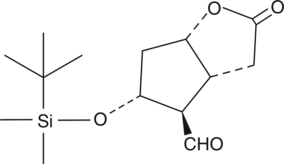Chemicals
Showing 37351–37500 of 41137 results
-
TBA-354 is a nitroimidazole antitubercular agent.{46935} It is active against clinical isolates of drug-resistant and -sensitive replicating M. tuberculosis (MICs = M. tuberculosis over M. scrofulaceum, M. gilvum, M. fortuitum, M. triviale, and M. smegmatis (MICs = >11.5 μM) but is active against M. bovis and M. kansasii (MICs = M. tuberculosis infection.
Brand:CaymanSKU:30317 - 10 mgAvailable on backorder
TBA-354 is a nitroimidazole antitubercular agent.{46935} It is active against clinical isolates of drug-resistant and -sensitive replicating M. tuberculosis (MICs = M. tuberculosis over M. scrofulaceum, M. gilvum, M. fortuitum, M. triviale, and M. smegmatis (MICs = >11.5 μM) but is active against M. bovis and M. kansasii (MICs = M. tuberculosis infection.
Brand:CaymanSKU:30317 - 100 mgAvailable on backorder
TBA-354 is a nitroimidazole antitubercular agent.{46935} It is active against clinical isolates of drug-resistant and -sensitive replicating M. tuberculosis (MICs = M. tuberculosis over M. scrofulaceum, M. gilvum, M. fortuitum, M. triviale, and M. smegmatis (MICs = >11.5 μM) but is active against M. bovis and M. kansasii (MICs = M. tuberculosis infection.
Brand:CaymanSKU:30317 - 250 mgAvailable on backorder
TBA-354 is a nitroimidazole antitubercular agent.{46935} It is active against clinical isolates of drug-resistant and -sensitive replicating M. tuberculosis (MICs = M. tuberculosis over M. scrofulaceum, M. gilvum, M. fortuitum, M. triviale, and M. smegmatis (MICs = >11.5 μM) but is active against M. bovis and M. kansasii (MICs = M. tuberculosis infection.
Brand:CaymanSKU:30317 - 50 mgAvailable on backorder
TBB is an ATP/GTP-competitive inhibitor of casein kinase 2 (CK2; IC50 = 0.15 µM for rat liver CK2).{22897} It also inhibits PIM3 and DYRK2 with IC50 values of 0.86 and 0.99 µM, respectively, and several other protein kinases with IC50 values in the low micromolar range but displays less than 10% inhibition at 26 additional kinases up to 10 µM.{22896,22897}
Brand:CaymanSKU:-TBB is an ATP/GTP-competitive inhibitor of casein kinase 2 (CK2; IC50 = 0.15 µM for rat liver CK2).{22897} It also inhibits PIM3 and DYRK2 with IC50 values of 0.86 and 0.99 µM, respectively, and several other protein kinases with IC50 values in the low micromolar range but displays less than 10% inhibition at 26 additional kinases up to 10 µM.{22896,22897}
Brand:CaymanSKU:-TBB is an ATP/GTP-competitive inhibitor of casein kinase 2 (CK2; IC50 = 0.15 µM for rat liver CK2).{22897} It also inhibits PIM3 and DYRK2 with IC50 values of 0.86 and 0.99 µM, respectively, and several other protein kinases with IC50 values in the low micromolar range but displays less than 10% inhibition at 26 additional kinases up to 10 µM.{22896,22897}
Brand:CaymanSKU:-TBB is an ATP/GTP-competitive inhibitor of casein kinase 2 (CK2; IC50 = 0.15 µM for rat liver CK2).{22897} It also inhibits PIM3 and DYRK2 with IC50 values of 0.86 and 0.99 µM, respectively, and several other protein kinases with IC50 values in the low micromolar range but displays less than 10% inhibition at 26 additional kinases up to 10 µM.{22896,22897}
Brand:CaymanSKU:-Casein kinase 2 (CK2) is a kinase with many targets and diverse roles in cell signaling and disease.{26170,26171} TBCA is a selective, cell-permeable inhibitor of CK2 (IC50 = 0.11 µM, Ki = 77 nM) that has minimal effect on a panel of 28 other kinases.{24973} It induces cell death in Jurkat adult T cell leukemia cells (DC50 = 7.7 µM), driving caspase-dependent degradation of poly-ADP ribose polymerase while inhibiting CK2 activity.{24973} TBCA also supports a role for CK2 in platelet function and Akt phosphorylation but not protein splicing.{26172,26173}
Brand:CaymanSKU:-Casein kinase 2 (CK2) is a kinase with many targets and diverse roles in cell signaling and disease.{26170,26171} TBCA is a selective, cell-permeable inhibitor of CK2 (IC50 = 0.11 µM, Ki = 77 nM) that has minimal effect on a panel of 28 other kinases.{24973} It induces cell death in Jurkat adult T cell leukemia cells (DC50 = 7.7 µM), driving caspase-dependent degradation of poly-ADP ribose polymerase while inhibiting CK2 activity.{24973} TBCA also supports a role for CK2 in platelet function and Akt phosphorylation but not protein splicing.{26172,26173}
Brand:CaymanSKU:-Casein kinase 2 (CK2) is a kinase with many targets and diverse roles in cell signaling and disease.{26170,26171} TBCA is a selective, cell-permeable inhibitor of CK2 (IC50 = 0.11 µM, Ki = 77 nM) that has minimal effect on a panel of 28 other kinases.{24973} It induces cell death in Jurkat adult T cell leukemia cells (DC50 = 7.7 µM), driving caspase-dependent degradation of poly-ADP ribose polymerase while inhibiting CK2 activity.{24973} TBCA also supports a role for CK2 in platelet function and Akt phosphorylation but not protein splicing.{26172,26173}
Brand:CaymanSKU:-Casein kinase 2 (CK2) is a kinase with many targets and diverse roles in cell signaling and disease.{26170,26171} TBCA is a selective, cell-permeable inhibitor of CK2 (IC50 = 0.11 µM, Ki = 77 nM) that has minimal effect on a panel of 28 other kinases.{24973} It induces cell death in Jurkat adult T cell leukemia cells (DC50 = 7.7 µM), driving caspase-dependent degradation of poly-ADP ribose polymerase while inhibiting CK2 activity.{24973} TBCA also supports a role for CK2 in platelet function and Akt phosphorylation but not protein splicing.{26172,26173}
Brand:CaymanSKU:-TBPB is an allosteric agonist of M1 muscarinic acetylcholine receptors (mAChRs; EC50 = 158 nM in CHO-K1 cells expressing rat recombinant receptors).{45505} It is selective for M1 over M2-5 receptors at concentrations up to 10 μM. TBPB (3 μM) potentiates NMDA-evoked currents in CA1 pyramidal cells. It increases production of the non-amyloidogenic amyloid precursor protein (APP) cleavage products APPsα and CTFα in PC12 cells overexpressing the human M1 receptor and APP when used at a concentration of 1 μM. TBPB decreases amphetamine-induced hyperlocomotion in a rat model that is predictive of antipsychotic-like activity.
Brand:CaymanSKU:22943 - 1 mgAvailable on backorder
TBPB is an allosteric agonist of M1 muscarinic acetylcholine receptors (mAChRs; EC50 = 158 nM in CHO-K1 cells expressing rat recombinant receptors).{45505} It is selective for M1 over M2-5 receptors at concentrations up to 10 μM. TBPB (3 μM) potentiates NMDA-evoked currents in CA1 pyramidal cells. It increases production of the non-amyloidogenic amyloid precursor protein (APP) cleavage products APPsα and CTFα in PC12 cells overexpressing the human M1 receptor and APP when used at a concentration of 1 μM. TBPB decreases amphetamine-induced hyperlocomotion in a rat model that is predictive of antipsychotic-like activity.
Brand:CaymanSKU:22943 - 10 mgAvailable on backorder
TBPB is an allosteric agonist of M1 muscarinic acetylcholine receptors (mAChRs; EC50 = 158 nM in CHO-K1 cells expressing rat recombinant receptors).{45505} It is selective for M1 over M2-5 receptors at concentrations up to 10 μM. TBPB (3 μM) potentiates NMDA-evoked currents in CA1 pyramidal cells. It increases production of the non-amyloidogenic amyloid precursor protein (APP) cleavage products APPsα and CTFα in PC12 cells overexpressing the human M1 receptor and APP when used at a concentration of 1 μM. TBPB decreases amphetamine-induced hyperlocomotion in a rat model that is predictive of antipsychotic-like activity.
Brand:CaymanSKU:22943 - 5 mgAvailable on backorder
TBS-Corey lactone aldehyde is a versatile, hydroxyl-protected intermediate for the synthesis of prostaglandins and prostaglandin analogs. Prostaglandin derivatives with modifications in the alpha chain, the omega chain, or both, are readily accessible from TBS-Corey aldehyde.{5004}
Brand:CaymanSKU:70031 - 1 gAvailable on backorder
TBS-Corey lactone aldehyde is a versatile, hydroxyl-protected intermediate for the synthesis of prostaglandins and prostaglandin analogs. Prostaglandin derivatives with modifications in the alpha chain, the omega chain, or both, are readily accessible from TBS-Corey aldehyde.{5004}
Brand:CaymanSKU:70031 - 5 gAvailable on backorder
TBS-Corey lactone aldehyde is a versatile, hydroxyl-protected intermediate for the synthesis of prostaglandins and prostaglandin analogs. Prostaglandin derivatives with modifications in the alpha chain, the omega chain, or both, are readily accessible from TBS-Corey aldehyde.{5004}
Brand:CaymanSKU:70031 - 500 mgAvailable on backorder
TBTA is a tertiary amine with three 1,2,3-triazole groups. It complexes with, and stabilizes, copper(I) to accelerate azide-alkyne cycloadditions, as used in click chemistry.{30492,30493}
Brand:CaymanSKU:-Available on backorder
TBTA is a tertiary amine with three 1,2,3-triazole groups. It complexes with, and stabilizes, copper(I) to accelerate azide-alkyne cycloadditions, as used in click chemistry.{30492,30493}
Brand:CaymanSKU:-Available on backorder
TBTA is a tertiary amine with three 1,2,3-triazole groups. It complexes with, and stabilizes, copper(I) to accelerate azide-alkyne cycloadditions, as used in click chemistry.{30492,30493}
Brand:CaymanSKU:-Available on backorder
TBTA is a tertiary amine with three 1,2,3-triazole groups. It complexes with, and stabilizes, copper(I) to accelerate azide-alkyne cycloadditions, as used in click chemistry.{30492,30493}
Brand:CaymanSKU:-Available on backorder
TC 2559 is a CNS-selective partial agonist for α4β2 subunit-containing nicotinic acetylcholine receptors (nAChRs) with an EC50 value of 0.18 µM for calcium signaling in HEK293 cells expressing human recombinant nAChRs.{46064,46065} It is selective for α4β2 over α2β4, α4β4, α3β4, α3β2, and α7 subunit-containing nAChRs (EC50s = 14, 12.5, >30, >100, and >100 µM, respectively). It increases dopamine cell firing in the rat ventral tegmental area (VTA) in vitro. TC 2559 increases spontaneous inhibitory postsynaptic currents (sIPSCs) in dorsal horn neurons, indicating an enhancement of inhibitory synaptic transmission, an effect that is blocked by the α4β2 subunit-containing nAChR antagonist DHβE.{46066} It reduces formalin-induced paw-licking time in mice when administered at doses of 3 and 10 mg/kg and increases paw withdrawal latency in a rat model of chronic constriction injury when administered at a dose of 3 mg/kg. TC 2559 (3 and 6 µmol/kg) also reverses cognitive deficits induced by scopolamine in rats, increasing step-through latency in a passive avoidance task.{46064}
Brand:CaymanSKU:25600 - 1 mgAvailable on backorder
TC 2559 is a CNS-selective partial agonist for α4β2 subunit-containing nicotinic acetylcholine receptors (nAChRs) with an EC50 value of 0.18 µM for calcium signaling in HEK293 cells expressing human recombinant nAChRs.{46064,46065} It is selective for α4β2 over α2β4, α4β4, α3β4, α3β2, and α7 subunit-containing nAChRs (EC50s = 14, 12.5, >30, >100, and >100 µM, respectively). It increases dopamine cell firing in the rat ventral tegmental area (VTA) in vitro. TC 2559 increases spontaneous inhibitory postsynaptic currents (sIPSCs) in dorsal horn neurons, indicating an enhancement of inhibitory synaptic transmission, an effect that is blocked by the α4β2 subunit-containing nAChR antagonist DHβE.{46066} It reduces formalin-induced paw-licking time in mice when administered at doses of 3 and 10 mg/kg and increases paw withdrawal latency in a rat model of chronic constriction injury when administered at a dose of 3 mg/kg. TC 2559 (3 and 6 µmol/kg) also reverses cognitive deficits induced by scopolamine in rats, increasing step-through latency in a passive avoidance task.{46064}
Brand:CaymanSKU:25600 - 10 mgAvailable on backorder
TC 2559 is a CNS-selective partial agonist for α4β2 subunit-containing nicotinic acetylcholine receptors (nAChRs) with an EC50 value of 0.18 µM for calcium signaling in HEK293 cells expressing human recombinant nAChRs.{46064,46065} It is selective for α4β2 over α2β4, α4β4, α3β4, α3β2, and α7 subunit-containing nAChRs (EC50s = 14, 12.5, >30, >100, and >100 µM, respectively). It increases dopamine cell firing in the rat ventral tegmental area (VTA) in vitro. TC 2559 increases spontaneous inhibitory postsynaptic currents (sIPSCs) in dorsal horn neurons, indicating an enhancement of inhibitory synaptic transmission, an effect that is blocked by the α4β2 subunit-containing nAChR antagonist DHβE.{46066} It reduces formalin-induced paw-licking time in mice when administered at doses of 3 and 10 mg/kg and increases paw withdrawal latency in a rat model of chronic constriction injury when administered at a dose of 3 mg/kg. TC 2559 (3 and 6 µmol/kg) also reverses cognitive deficits induced by scopolamine in rats, increasing step-through latency in a passive avoidance task.{46064}
Brand:CaymanSKU:25600 - 25 mgAvailable on backorder
TC 2559 is a CNS-selective partial agonist for α4β2 subunit-containing nicotinic acetylcholine receptors (nAChRs) with an EC50 value of 0.18 µM for calcium signaling in HEK293 cells expressing human recombinant nAChRs.{46064,46065} It is selective for α4β2 over α2β4, α4β4, α3β4, α3β2, and α7 subunit-containing nAChRs (EC50s = 14, 12.5, >30, >100, and >100 µM, respectively). It increases dopamine cell firing in the rat ventral tegmental area (VTA) in vitro. TC 2559 increases spontaneous inhibitory postsynaptic currents (sIPSCs) in dorsal horn neurons, indicating an enhancement of inhibitory synaptic transmission, an effect that is blocked by the α4β2 subunit-containing nAChR antagonist DHβE.{46066} It reduces formalin-induced paw-licking time in mice when administered at doses of 3 and 10 mg/kg and increases paw withdrawal latency in a rat model of chronic constriction injury when administered at a dose of 3 mg/kg. TC 2559 (3 and 6 µmol/kg) also reverses cognitive deficits induced by scopolamine in rats, increasing step-through latency in a passive avoidance task.{46064}
Brand:CaymanSKU:25600 - 5 mgAvailable on backorder
TC HSD 21 is an inhibitor of 17β-hydroxysteroid dehydrogenase type 3 (17β-HSD3; IC50 = 14 nM in HeLa cells expressing the recombinant human enzyme).{57064} It is selective for 17β-HSD3 over 17β-HSD1, 17β-HSD2, estrogen receptor α (ERα), the androgen receptor, and the glucocorticoid receptor.
Brand:CaymanSKU:29730 - 1 mgAvailable on backorder
TC HSD 21 is an inhibitor of 17β-hydroxysteroid dehydrogenase type 3 (17β-HSD3; IC50 = 14 nM in HeLa cells expressing the recombinant human enzyme).{57064} It is selective for 17β-HSD3 over 17β-HSD1, 17β-HSD2, estrogen receptor α (ERα), the androgen receptor, and the glucocorticoid receptor.
Brand:CaymanSKU:29730 - 5 mgAvailable on backorder
TC-E 5002 is an inhibitor of the histone lysine demethylase (KDM) subfamily KDM2/7 (IC50s = 6.8, 0.2, and 1.2 µM for KDM2A, KDM7A, and KDM7B, respectively).{39306} It is selective for the KDM2/7 subfamily over KDM4A, KDM4C, KDM5A, and KDM6A/UTX (IC50s = >120, 83, 55, and 100 µM, respectively). It inhibits the growth of N2a, KYSE150, and HeLa cells with GI50 values of 86, 16, and 40 µM, respectively, which are in the range where it increases H3K27me2 levels in KYSE150 and HeLa cells. TC-E 5002 decreases gene expression of E2F1, a transcription factor activated by KDM7B that leads to progression of the cell cycle. In addition, TC-E 5002 treatment leads to cell cycle arrest at the G0/G1 phase in KYSE150 and HeLa cells.
Brand:CaymanSKU:-Available on backorder
TC-E 5002 is an inhibitor of the histone lysine demethylase (KDM) subfamily KDM2/7 (IC50s = 6.8, 0.2, and 1.2 µM for KDM2A, KDM7A, and KDM7B, respectively).{39306} It is selective for the KDM2/7 subfamily over KDM4A, KDM4C, KDM5A, and KDM6A/UTX (IC50s = >120, 83, 55, and 100 µM, respectively). It inhibits the growth of N2a, KYSE150, and HeLa cells with GI50 values of 86, 16, and 40 µM, respectively, which are in the range where it increases H3K27me2 levels in KYSE150 and HeLa cells. TC-E 5002 decreases gene expression of E2F1, a transcription factor activated by KDM7B that leads to progression of the cell cycle. In addition, TC-E 5002 treatment leads to cell cycle arrest at the G0/G1 phase in KYSE150 and HeLa cells.
Brand:CaymanSKU:-Available on backorder
TC-E 5002 is an inhibitor of the histone lysine demethylase (KDM) subfamily KDM2/7 (IC50s = 6.8, 0.2, and 1.2 µM for KDM2A, KDM7A, and KDM7B, respectively).{39306} It is selective for the KDM2/7 subfamily over KDM4A, KDM4C, KDM5A, and KDM6A/UTX (IC50s = >120, 83, 55, and 100 µM, respectively). It inhibits the growth of N2a, KYSE150, and HeLa cells with GI50 values of 86, 16, and 40 µM, respectively, which are in the range where it increases H3K27me2 levels in KYSE150 and HeLa cells. TC-E 5002 decreases gene expression of E2F1, a transcription factor activated by KDM7B that leads to progression of the cell cycle. In addition, TC-E 5002 treatment leads to cell cycle arrest at the G0/G1 phase in KYSE150 and HeLa cells.
Brand:CaymanSKU:-Available on backorder
TC-E 5002 is an inhibitor of the histone lysine demethylase (KDM) subfamily KDM2/7 (IC50s = 6.8, 0.2, and 1.2 µM for KDM2A, KDM7A, and KDM7B, respectively).{39306} It is selective for the KDM2/7 subfamily over KDM4A, KDM4C, KDM5A, and KDM6A/UTX (IC50s = >120, 83, 55, and 100 µM, respectively). It inhibits the growth of N2a, KYSE150, and HeLa cells with GI50 values of 86, 16, and 40 µM, respectively, which are in the range where it increases H3K27me2 levels in KYSE150 and HeLa cells. TC-E 5002 decreases gene expression of E2F1, a transcription factor activated by KDM7B that leads to progression of the cell cycle. In addition, TC-E 5002 treatment leads to cell cycle arrest at the G0/G1 phase in KYSE150 and HeLa cells.
Brand:CaymanSKU:-Available on backorder
TC-E 5003 is an inhibitor of protein arginine methyltransferase 1 (PRMT1; IC50 = 1.5 µM for human PRMT1 in a methylation assay).{38415} It is selective for PRMT1 over PRMT4/CARM1 and SET7/9 methyltransferases, with less than 5% inhibition at a concentration of 50 µM for SET7/9. TC-E 5003 inhibits growth of MCF-7a breast cancer and LNCaP prostate cancer cells (GI50s = 1.97 and 4.49 µM, respectively) and decreases androgen-dependent gene transcription in vitro. TC-E 5003 (80 mg/kg) also has antimalarial properties and eradicates P. berghei in mice.{38416}
Brand:CaymanSKU:-Available on backorder
TC-E 5003 is an inhibitor of protein arginine methyltransferase 1 (PRMT1; IC50 = 1.5 µM for human PRMT1 in a methylation assay).{38415} It is selective for PRMT1 over PRMT4/CARM1 and SET7/9 methyltransferases, with less than 5% inhibition at a concentration of 50 µM for SET7/9. TC-E 5003 inhibits growth of MCF-7a breast cancer and LNCaP prostate cancer cells (GI50s = 1.97 and 4.49 µM, respectively) and decreases androgen-dependent gene transcription in vitro. TC-E 5003 (80 mg/kg) also has antimalarial properties and eradicates P. berghei in mice.{38416}
Brand:CaymanSKU:-Available on backorder
TC-E 5003 is an inhibitor of protein arginine methyltransferase 1 (PRMT1; IC50 = 1.5 µM for human PRMT1 in a methylation assay).{38415} It is selective for PRMT1 over PRMT4/CARM1 and SET7/9 methyltransferases, with less than 5% inhibition at a concentration of 50 µM for SET7/9. TC-E 5003 inhibits growth of MCF-7a breast cancer and LNCaP prostate cancer cells (GI50s = 1.97 and 4.49 µM, respectively) and decreases androgen-dependent gene transcription in vitro. TC-E 5003 (80 mg/kg) also has antimalarial properties and eradicates P. berghei in mice.{38416}
Brand:CaymanSKU:-Available on backorder
TC-E 5003 is an inhibitor of protein arginine methyltransferase 1 (PRMT1; IC50 = 1.5 µM for human PRMT1 in a methylation assay).{38415} It is selective for PRMT1 over PRMT4/CARM1 and SET7/9 methyltransferases, with less than 5% inhibition at a concentration of 50 µM for SET7/9. TC-E 5003 inhibits growth of MCF-7a breast cancer and LNCaP prostate cancer cells (GI50s = 1.97 and 4.49 µM, respectively) and decreases androgen-dependent gene transcription in vitro. TC-E 5003 (80 mg/kg) also has antimalarial properties and eradicates P. berghei in mice.{38416}
Brand:CaymanSKU:-Available on backorder
TC-E3 5032 is a precursor in the synthesis of homodimeric proteolysis-targeting chimera technologies (PROTACs).{46128} It has been used to attach various linkers at position 4 to produce alkylated pomalidomide derivatives as intermediates in the synthesis of homodimeric PROTACs. It has also been used as an intermediate in the synthesis of HDAC6 and anaplastic lymphoma kinase (ALK) degraders.{46129,46130}
Brand:CaymanSKU:26147 - 100 mgAvailable on backorder
TC-E3 5032 is a precursor in the synthesis of homodimeric proteolysis-targeting chimera technologies (PROTACs).{46128} It has been used to attach various linkers at position 4 to produce alkylated pomalidomide derivatives as intermediates in the synthesis of homodimeric PROTACs. It has also been used as an intermediate in the synthesis of HDAC6 and anaplastic lymphoma kinase (ALK) degraders.{46129,46130}
Brand:CaymanSKU:26147 - 250 mgAvailable on backorder
TC-E3 5032 is a precursor in the synthesis of homodimeric proteolysis-targeting chimera technologies (PROTACs).{46128} It has been used to attach various linkers at position 4 to produce alkylated pomalidomide derivatives as intermediates in the synthesis of homodimeric PROTACs. It has also been used as an intermediate in the synthesis of HDAC6 and anaplastic lymphoma kinase (ALK) degraders.{46129,46130}
Brand:CaymanSKU:26147 - 50 mgAvailable on backorder
TC-E3 5032 is a precursor in the synthesis of homodimeric proteolysis-targeting chimera technologies (PROTACs).{46128} It has been used to attach various linkers at position 4 to produce alkylated pomalidomide derivatives as intermediates in the synthesis of homodimeric PROTACs. It has also been used as an intermediate in the synthesis of HDAC6 and anaplastic lymphoma kinase (ALK) degraders.{46129,46130}
Brand:CaymanSKU:26147 - 500 mgAvailable on backorder
TC-FPR 43 is an agonist of formyl peptide receptor 1 (FPR1) and FPR2, which was previously known as formyl peptide receptor-like 1 (FPRL1).{52690,52691} TC-FPR 43 induces calcium flux in CHO cells expressing human FPR2, Gα15, and aequorin (EC50 = 0.044 µM) and in CHO-K1 cells expressing either human FPR1, human FPR2, mouse Fpr1, or mouse Fpr2, Gα16, and aequorin in a concentration-dependent manner.{52691} TC-FPR 43 inhibits migration of polymorphonuclear (PMN) neutrophils induced by fMLP (Item No. 21495) or IL-8 with IC50 values of 0.64 and 0.24 µM, respectively.{52690} It also reduces ear swelling induced by prostaglandin E2 (PGE2; Item No. 14010) and leukotriene B4 (LTB4; Item No. 20110) in mice when administered at a dose of 50 mg/kg.
Brand:CaymanSKU:29804 - 10 mgAvailable on backorder
TC-FPR 43 is an agonist of formyl peptide receptor 1 (FPR1) and FPR2, which was previously known as formyl peptide receptor-like 1 (FPRL1).{52690,52691} TC-FPR 43 induces calcium flux in CHO cells expressing human FPR2, Gα15, and aequorin (EC50 = 0.044 µM) and in CHO-K1 cells expressing either human FPR1, human FPR2, mouse Fpr1, or mouse Fpr2, Gα16, and aequorin in a concentration-dependent manner.{52691} TC-FPR 43 inhibits migration of polymorphonuclear (PMN) neutrophils induced by fMLP (Item No. 21495) or IL-8 with IC50 values of 0.64 and 0.24 µM, respectively.{52690} It also reduces ear swelling induced by prostaglandin E2 (PGE2; Item No. 14010) and leukotriene B4 (LTB4; Item No. 20110) in mice when administered at a dose of 50 mg/kg.
Brand:CaymanSKU:29804 - 25 mgAvailable on backorder
TC-FPR 43 is an agonist of formyl peptide receptor 1 (FPR1) and FPR2, which was previously known as formyl peptide receptor-like 1 (FPRL1).{52690,52691} TC-FPR 43 induces calcium flux in CHO cells expressing human FPR2, Gα15, and aequorin (EC50 = 0.044 µM) and in CHO-K1 cells expressing either human FPR1, human FPR2, mouse Fpr1, or mouse Fpr2, Gα16, and aequorin in a concentration-dependent manner.{52691} TC-FPR 43 inhibits migration of polymorphonuclear (PMN) neutrophils induced by fMLP (Item No. 21495) or IL-8 with IC50 values of 0.64 and 0.24 µM, respectively.{52690} It also reduces ear swelling induced by prostaglandin E2 (PGE2; Item No. 14010) and leukotriene B4 (LTB4; Item No. 20110) in mice when administered at a dose of 50 mg/kg.
Brand:CaymanSKU:29804 - 5 mgAvailable on backorder
TC-FPR 43 is an agonist of formyl peptide receptor 1 (FPR1) and FPR2, which was previously known as formyl peptide receptor-like 1 (FPRL1).{52690,52691} TC-FPR 43 induces calcium flux in CHO cells expressing human FPR2, Gα15, and aequorin (EC50 = 0.044 µM) and in CHO-K1 cells expressing either human FPR1, human FPR2, mouse Fpr1, or mouse Fpr2, Gα16, and aequorin in a concentration-dependent manner.{52691} TC-FPR 43 inhibits migration of polymorphonuclear (PMN) neutrophils induced by fMLP (Item No. 21495) or IL-8 with IC50 values of 0.64 and 0.24 µM, respectively.{52690} It also reduces ear swelling induced by prostaglandin E2 (PGE2; Item No. 14010) and leukotriene B4 (LTB4; Item No. 20110) in mice when administered at a dose of 50 mg/kg.
Brand:CaymanSKU:29804 - 50 mgAvailable on backorder
TC-O 9311 is an agonist of the orphan G protein-coupled receptor GPR139 (EC50 = 39 nM in a calcium mobilization assay).{42984} It is selective for GPR139 over a panel of 90 additional targets. TC-O 9311 (1 μM) inhibits cell death induced by 1-methyl-4-phenylpyridinium (MPP+), but not 6-hydroxydopamine (6-OHDA; Item No. 25330), in primary dopaminergic midbrain neurons.{42985}
Brand:CaymanSKU:-TC-O 9311 is an agonist of the orphan G protein-coupled receptor GPR139 (EC50 = 39 nM in a calcium mobilization assay).{42984} It is selective for GPR139 over a panel of 90 additional targets. TC-O 9311 (1 μM) inhibits cell death induced by 1-methyl-4-phenylpyridinium (MPP+), but not 6-hydroxydopamine (6-OHDA; Item No. 25330), in primary dopaminergic midbrain neurons.{42985}
Brand:CaymanSKU:-TC-O 9311 is an agonist of the orphan G protein-coupled receptor GPR139 (EC50 = 39 nM in a calcium mobilization assay).{42984} It is selective for GPR139 over a panel of 90 additional targets. TC-O 9311 (1 μM) inhibits cell death induced by 1-methyl-4-phenylpyridinium (MPP+), but not 6-hydroxydopamine (6-OHDA; Item No. 25330), in primary dopaminergic midbrain neurons.{42985}
Brand:CaymanSKU:-TC-O 9311 is an agonist of the orphan G protein-coupled receptor GPR139 (EC50 = 39 nM in a calcium mobilization assay).{42984} It is selective for GPR139 over a panel of 90 additional targets. TC-O 9311 (1 μM) inhibits cell death induced by 1-methyl-4-phenylpyridinium (MPP+), but not 6-hydroxydopamine (6-OHDA; Item No. 25330), in primary dopaminergic midbrain neurons.{42985}
Brand:CaymanSKU:-TC-S 7001 is an inhibitor of Rho-associated kinase (ROCK; IC50s = 0.6 and 1.1 nM, respectively, for human ROCK-I and ROCK-II).{48172} It is selective for ROCK over myosin light-chain kinase (MLCK) and zipper-interacting protein kinase (ZIP-kinase; IC50s = 7,400 and 4,100 nM, respectively), as well as 110 kinases in a panel at 1-10 µM, but does inhibit TRK and FLT3 (IC50s = 252 and 303 nM, respectively). TC-S 7001 reduces ROCK-II-induced phosphorylation of human myosin-binding subunit (MBS) when used at a concentration of 3 nM and decreases ROCK-II autophosphorylation. It inhibits contraction of isolated rabbit saphenous artery induced by phenylephrine (IC50 = 65 nM) and decreases blood pressure in normotensive and hypertensive rats when administered at doses of 3 and 10 mg/kg. TC-S 7001 also decreases right ventricular systolic pressure and total pulmonary resistance in a rat model of monocrotaline-induced pulmonary hypertension when administered at a dose of 10 mg/kg per day.{48173}
Brand:CaymanSKU:-Available on backorder
TC-S 7001 is an inhibitor of Rho-associated kinase (ROCK; IC50s = 0.6 and 1.1 nM, respectively, for human ROCK-I and ROCK-II).{48172} It is selective for ROCK over myosin light-chain kinase (MLCK) and zipper-interacting protein kinase (ZIP-kinase; IC50s = 7,400 and 4,100 nM, respectively), as well as 110 kinases in a panel at 1-10 µM, but does inhibit TRK and FLT3 (IC50s = 252 and 303 nM, respectively). TC-S 7001 reduces ROCK-II-induced phosphorylation of human myosin-binding subunit (MBS) when used at a concentration of 3 nM and decreases ROCK-II autophosphorylation. It inhibits contraction of isolated rabbit saphenous artery induced by phenylephrine (IC50 = 65 nM) and decreases blood pressure in normotensive and hypertensive rats when administered at doses of 3 and 10 mg/kg. TC-S 7001 also decreases right ventricular systolic pressure and total pulmonary resistance in a rat model of monocrotaline-induced pulmonary hypertension when administered at a dose of 10 mg/kg per day.{48173}
Brand:CaymanSKU:-Available on backorder
TC-S 7001 is an inhibitor of Rho-associated kinase (ROCK; IC50s = 0.6 and 1.1 nM, respectively, for human ROCK-I and ROCK-II).{48172} It is selective for ROCK over myosin light-chain kinase (MLCK) and zipper-interacting protein kinase (ZIP-kinase; IC50s = 7,400 and 4,100 nM, respectively), as well as 110 kinases in a panel at 1-10 µM, but does inhibit TRK and FLT3 (IC50s = 252 and 303 nM, respectively). TC-S 7001 reduces ROCK-II-induced phosphorylation of human myosin-binding subunit (MBS) when used at a concentration of 3 nM and decreases ROCK-II autophosphorylation. It inhibits contraction of isolated rabbit saphenous artery induced by phenylephrine (IC50 = 65 nM) and decreases blood pressure in normotensive and hypertensive rats when administered at doses of 3 and 10 mg/kg. TC-S 7001 also decreases right ventricular systolic pressure and total pulmonary resistance in a rat model of monocrotaline-induced pulmonary hypertension when administered at a dose of 10 mg/kg per day.{48173}
Brand:CaymanSKU:-Available on backorder
TCEP is an odorless, selective, and water-soluble reducing agent that is commonly used in many laboratory applications. It is commonly used to rapidly reduce protein and peptide disulfide bonds. TCEP can be combined with proteases to simultaneously reduce and digest proteins prior to mass spectrometry in order to dramatically increase sequence coverage.{23135} It has also been used to measure ascorbic acid and dehydroascorbic acid in biological samples.{23137,23136}
Brand:CaymanSKU:-Ubiquitin carboxyl-terminal hydrolase isozyme L3 (UCH-L3) is a deubiquitinating enzyme and thiol-dependent hydrolase.{26679,26681,26680,26678} TCID is a tetrachloro indandione that acts as a potent inhibitor of UCH-L3 and demonstrates 125-fold selectivity over UCH-L1 (IC50s = 0.6 and 75 µM, respectively).{25200}
Brand:CaymanSKU:-Out of stock
Ubiquitin carboxyl-terminal hydrolase isozyme L3 (UCH-L3) is a deubiquitinating enzyme and thiol-dependent hydrolase.{26679,26681,26680,26678} TCID is a tetrachloro indandione that acts as a potent inhibitor of UCH-L3 and demonstrates 125-fold selectivity over UCH-L1 (IC50s = 0.6 and 75 µM, respectively).{25200}
Brand:CaymanSKU:-Out of stock
Ubiquitin carboxyl-terminal hydrolase isozyme L3 (UCH-L3) is a deubiquitinating enzyme and thiol-dependent hydrolase.{26679,26681,26680,26678} TCID is a tetrachloro indandione that acts as a potent inhibitor of UCH-L3 and demonstrates 125-fold selectivity over UCH-L1 (IC50s = 0.6 and 75 µM, respectively).{25200}
Brand:CaymanSKU:-Out of stock
TCN 201 is a selective antagonist of NMDA receptors containing the NR2A subunit (pIC50s = 6.8 and <4.3 for human recombinant NR2A and NR2B, respectively).{30884} It has been shown to bind to a novel allosteric site located at the dimer interface between the GluN1 and GluN2 binding domains, thereby reducing glycine signal transduction and inhibiting NMDA receptor function.{30885}
Brand:CaymanSKU:-Available on backorder
TCN 201 is a selective antagonist of NMDA receptors containing the NR2A subunit (pIC50s = 6.8 and <4.3 for human recombinant NR2A and NR2B, respectively).{30884} It has been shown to bind to a novel allosteric site located at the dimer interface between the GluN1 and GluN2 binding domains, thereby reducing glycine signal transduction and inhibiting NMDA receptor function.{30885}
Brand:CaymanSKU:-Available on backorder
TCN 201 is a selective antagonist of NMDA receptors containing the NR2A subunit (pIC50s = 6.8 and <4.3 for human recombinant NR2A and NR2B, respectively).{30884} It has been shown to bind to a novel allosteric site located at the dimer interface between the GluN1 and GluN2 binding domains, thereby reducing glycine signal transduction and inhibiting NMDA receptor function.{30885}
Brand:CaymanSKU:-Available on backorder
TCN 238 is an orally bioavailable positive allosteric modulator of the metabotropic glutamate receptor 4 (mGluR4; EC50 = 1 µM).{40126} It has a greater than 30-fold selectivity for mGluR4 over mGluR5 using human recombinant receptors in CHO-K1 cells. It has no activity at the adenosine A2A, serotonin 5-HT1A, or α2A-adrenergic receptors at concentrations up to 10 µM. In a haloperidol-induced catalepsy rat model of Parkinson’s disease, it dose-dependently reduces catalepsy with an ED50 of approximately 1 mg/kg. TCN 238 administration in rats leads to downregulation of the mGluR4 gene, GRM4, in the hippocampus and the gene for the GABAA receptor α subunit, GABRA1, in the frontal cortex without affecting hippocampal-dependent memory.{40127}
Brand:CaymanSKU:11994 - 10 mgAvailable on backorder
TCN 238 is an orally bioavailable positive allosteric modulator of the metabotropic glutamate receptor 4 (mGluR4; EC50 = 1 µM).{40126} It has a greater than 30-fold selectivity for mGluR4 over mGluR5 using human recombinant receptors in CHO-K1 cells. It has no activity at the adenosine A2A, serotonin 5-HT1A, or α2A-adrenergic receptors at concentrations up to 10 µM. In a haloperidol-induced catalepsy rat model of Parkinson’s disease, it dose-dependently reduces catalepsy with an ED50 of approximately 1 mg/kg. TCN 238 administration in rats leads to downregulation of the mGluR4 gene, GRM4, in the hippocampus and the gene for the GABAA receptor α subunit, GABRA1, in the frontal cortex without affecting hippocampal-dependent memory.{40127}
Brand:CaymanSKU:11994 - 25 mgAvailable on backorder
TCN 238 is an orally bioavailable positive allosteric modulator of the metabotropic glutamate receptor 4 (mGluR4; EC50 = 1 µM).{40126} It has a greater than 30-fold selectivity for mGluR4 over mGluR5 using human recombinant receptors in CHO-K1 cells. It has no activity at the adenosine A2A, serotonin 5-HT1A, or α2A-adrenergic receptors at concentrations up to 10 µM. In a haloperidol-induced catalepsy rat model of Parkinson’s disease, it dose-dependently reduces catalepsy with an ED50 of approximately 1 mg/kg. TCN 238 administration in rats leads to downregulation of the mGluR4 gene, GRM4, in the hippocampus and the gene for the GABAA receptor α subunit, GABRA1, in the frontal cortex without affecting hippocampal-dependent memory.{40127}
Brand:CaymanSKU:11994 - 5 mgAvailable on backorder
The mouse constitutive androstane receptor (mCAR), with the retinoid X receptor, binds to the retinoic acid response element to upregulate the expression of proteins that metabolize xenobiotics.{27657} TCPOBOP is an agonist for mCAR (EC50 = 20 nM) that is effective for the mouse receptor but not for human or rat CAR receptors.{27661,27663} Through its effects on mCAR, TCPOBOP potently induces cytochrome P450 monooxygenases and multidrug resistance and xenobiotic efflux proteins.{27659,27662,27658} The action of TCPOBOP on mCAR-mediated gene expression can be repressed by retinoic acids.{27660}
Brand:CaymanSKU:-The mouse constitutive androstane receptor (mCAR), with the retinoid X receptor, binds to the retinoic acid response element to upregulate the expression of proteins that metabolize xenobiotics.{27657} TCPOBOP is an agonist for mCAR (EC50 = 20 nM) that is effective for the mouse receptor but not for human or rat CAR receptors.{27661,27663} Through its effects on mCAR, TCPOBOP potently induces cytochrome P450 monooxygenases and multidrug resistance and xenobiotic efflux proteins.{27659,27662,27658} The action of TCPOBOP on mCAR-mediated gene expression can be repressed by retinoic acids.{27660}
Brand:CaymanSKU:-The mouse constitutive androstane receptor (mCAR), with the retinoid X receptor, binds to the retinoic acid response element to upregulate the expression of proteins that metabolize xenobiotics.{27657} TCPOBOP is an agonist for mCAR (EC50 = 20 nM) that is effective for the mouse receptor but not for human or rat CAR receptors.{27661,27663} Through its effects on mCAR, TCPOBOP potently induces cytochrome P450 monooxygenases and multidrug resistance and xenobiotic efflux proteins.{27659,27662,27658} The action of TCPOBOP on mCAR-mediated gene expression can be repressed by retinoic acids.{27660}
Brand:CaymanSKU:-The mouse constitutive androstane receptor (mCAR), with the retinoid X receptor, binds to the retinoic acid response element to upregulate the expression of proteins that metabolize xenobiotics.{27657} TCPOBOP is an agonist for mCAR (EC50 = 20 nM) that is effective for the mouse receptor but not for human or rat CAR receptors.{27661,27663} Through its effects on mCAR, TCPOBOP potently induces cytochrome P450 monooxygenases and multidrug resistance and xenobiotic efflux proteins.{27659,27662,27658} The action of TCPOBOP on mCAR-mediated gene expression can be repressed by retinoic acids.{27660}
Brand:CaymanSKU:-Orexin receptors 1 (OX1R) and OX2R mediate the action of the neuropeptides orexin A and orexin B. TCS 1102 is a dual antagonist of both OX1R and OX2R (Kis = 0.2 and 3 nM, respectively).{29783} It is a poor substrate for P-glycoprotein and, as a result, demonstrates good brain penetration when administered intraperitoneally.{29783} Dual orexin receptor antagonists, including TCS 1102, promote sleep and prevent drug-induced plasticity and drug relapse.{29785} Systemic injection of TCS 1102 (10 mg/kg i.p.) in rats decreases fear and anxiety in response to acute episodes of stress.{29784}
Brand:CaymanSKU:-Available on backorder
Orexin receptors 1 (OX1R) and OX2R mediate the action of the neuropeptides orexin A and orexin B. TCS 1102 is a dual antagonist of both OX1R and OX2R (Kis = 0.2 and 3 nM, respectively).{29783} It is a poor substrate for P-glycoprotein and, as a result, demonstrates good brain penetration when administered intraperitoneally.{29783} Dual orexin receptor antagonists, including TCS 1102, promote sleep and prevent drug-induced plasticity and drug relapse.{29785} Systemic injection of TCS 1102 (10 mg/kg i.p.) in rats decreases fear and anxiety in response to acute episodes of stress.{29784}
Brand:CaymanSKU:-Available on backorder
Orexin receptors 1 (OX1R) and OX2R mediate the action of the neuropeptides orexin A and orexin B. TCS 1102 is a dual antagonist of both OX1R and OX2R (Kis = 0.2 and 3 nM, respectively).{29783} It is a poor substrate for P-glycoprotein and, as a result, demonstrates good brain penetration when administered intraperitoneally.{29783} Dual orexin receptor antagonists, including TCS 1102, promote sleep and prevent drug-induced plasticity and drug relapse.{29785} Systemic injection of TCS 1102 (10 mg/kg i.p.) in rats decreases fear and anxiety in response to acute episodes of stress.{29784}
Brand:CaymanSKU:-Available on backorder
TCS 21311 is an inhibitor of JAK3 (IC50 = 8 nM in an enzyme assay).{53897} It is selective for JAK3 over JAK1, JAK2, and tyrosine kinase 2 (TYK2; IC50s = 1,017, 2,550, and 8,055 nM, respectively) but does inhibit glycogen synthase kinase 3β (GSK-3β), PKCα, and PKCθ (IC50s = 13, 68, and 3 nM, respectively). TCS 21311 inhibits cytokine-induced STAT5 phosphorylation, a JAK3-dependent activity, in CTLL and M-07 cells (IC50s = 1,294 and 525 nM, respectively) and inhibits TCR/CD28-mediated T cell activation, a PCK-dependent activity, in Jurkat cells (IC50 = 689 nM). It also increases proliferation of mouse embryonic nephron progenitor cells (NPCs) and NPCs derived from human induced pluripotent stem cells (iPSCs) in the absence of bone morphogenic protein 7 (BMP7) when used at a concentration of 0.3 µM.{53898}
Brand:CaymanSKU:30063 - 1 mgAvailable on backorder
TCS 21311 is an inhibitor of JAK3 (IC50 = 8 nM in an enzyme assay).{53897} It is selective for JAK3 over JAK1, JAK2, and tyrosine kinase 2 (TYK2; IC50s = 1,017, 2,550, and 8,055 nM, respectively) but does inhibit glycogen synthase kinase 3β (GSK-3β), PKCα, and PKCθ (IC50s = 13, 68, and 3 nM, respectively). TCS 21311 inhibits cytokine-induced STAT5 phosphorylation, a JAK3-dependent activity, in CTLL and M-07 cells (IC50s = 1,294 and 525 nM, respectively) and inhibits TCR/CD28-mediated T cell activation, a PCK-dependent activity, in Jurkat cells (IC50 = 689 nM). It also increases proliferation of mouse embryonic nephron progenitor cells (NPCs) and NPCs derived from human induced pluripotent stem cells (iPSCs) in the absence of bone morphogenic protein 7 (BMP7) when used at a concentration of 0.3 µM.{53898}
Brand:CaymanSKU:30063 - 10 mgAvailable on backorder
TCS 21311 is an inhibitor of JAK3 (IC50 = 8 nM in an enzyme assay).{53897} It is selective for JAK3 over JAK1, JAK2, and tyrosine kinase 2 (TYK2; IC50s = 1,017, 2,550, and 8,055 nM, respectively) but does inhibit glycogen synthase kinase 3β (GSK-3β), PKCα, and PKCθ (IC50s = 13, 68, and 3 nM, respectively). TCS 21311 inhibits cytokine-induced STAT5 phosphorylation, a JAK3-dependent activity, in CTLL and M-07 cells (IC50s = 1,294 and 525 nM, respectively) and inhibits TCR/CD28-mediated T cell activation, a PCK-dependent activity, in Jurkat cells (IC50 = 689 nM). It also increases proliferation of mouse embryonic nephron progenitor cells (NPCs) and NPCs derived from human induced pluripotent stem cells (iPSCs) in the absence of bone morphogenic protein 7 (BMP7) when used at a concentration of 0.3 µM.{53898}
Brand:CaymanSKU:30063 - 25 mgAvailable on backorder
TCS 21311 is an inhibitor of JAK3 (IC50 = 8 nM in an enzyme assay).{53897} It is selective for JAK3 over JAK1, JAK2, and tyrosine kinase 2 (TYK2; IC50s = 1,017, 2,550, and 8,055 nM, respectively) but does inhibit glycogen synthase kinase 3β (GSK-3β), PKCα, and PKCθ (IC50s = 13, 68, and 3 nM, respectively). TCS 21311 inhibits cytokine-induced STAT5 phosphorylation, a JAK3-dependent activity, in CTLL and M-07 cells (IC50s = 1,294 and 525 nM, respectively) and inhibits TCR/CD28-mediated T cell activation, a PCK-dependent activity, in Jurkat cells (IC50 = 689 nM). It also increases proliferation of mouse embryonic nephron progenitor cells (NPCs) and NPCs derived from human induced pluripotent stem cells (iPSCs) in the absence of bone morphogenic protein 7 (BMP7) when used at a concentration of 0.3 µM.{53898}
Brand:CaymanSKU:30063 - 5 mgAvailable on backorder
TCS 2210 is a small molecule inducer of neuronal differentiation.{39439} It increases expression of the neuronal markers β-III tubulin and neuron-specific enolase (NSE) and induces neurite outgrowth in a population of PC12 neuronal precursor-like cells. TCS 2210 (20 μM per day for two days) converts >95% of a rat mesenchymal stem cell (MSC) population to a neuronal phenotype that exhibits potassium outward currents and increased expression of β-III tubulin and NSE as well as the cholinergic genes CHRNA2, CHRNAB, and CHRM4.
Brand:CaymanSKU:-TCS 2210 is a small molecule inducer of neuronal differentiation.{39439} It increases expression of the neuronal markers β-III tubulin and neuron-specific enolase (NSE) and induces neurite outgrowth in a population of PC12 neuronal precursor-like cells. TCS 2210 (20 μM per day for two days) converts >95% of a rat mesenchymal stem cell (MSC) population to a neuronal phenotype that exhibits potassium outward currents and increased expression of β-III tubulin and NSE as well as the cholinergic genes CHRNA2, CHRNAB, and CHRM4.
Brand:CaymanSKU:-TCS 2210 is a small molecule inducer of neuronal differentiation.{39439} It increases expression of the neuronal markers β-III tubulin and neuron-specific enolase (NSE) and induces neurite outgrowth in a population of PC12 neuronal precursor-like cells. TCS 2210 (20 μM per day for two days) converts >95% of a rat mesenchymal stem cell (MSC) population to a neuronal phenotype that exhibits potassium outward currents and increased expression of β-III tubulin and NSE as well as the cholinergic genes CHRNA2, CHRNAB, and CHRM4.
Brand:CaymanSKU:-TCS 401 is a selective inhibitor of protein-tyrosine phosphatase 1B (PTP1B; Ki = 0.29 µM).{32495} It inhibits the protein phosphatases CD45 D1D2, PTPβ, PTPε D1, SHP-1, PTPα D1, and LAR D1D2 at much higher concentrations (Kis = 59, 560, 1,100, >2,000, >2,000, and >2,000 μM, respectively).{32495} Several PTPs have been proposed to act as negative regulators of insulin signaling, thus this enzyme is a potential drug target in diabetes.
Brand:CaymanSKU:20393 -Available on backorder
TCS 401 is a selective inhibitor of protein-tyrosine phosphatase 1B (PTP1B; Ki = 0.29 µM).{32495} It inhibits the protein phosphatases CD45 D1D2, PTPβ, PTPε D1, SHP-1, PTPα D1, and LAR D1D2 at much higher concentrations (Kis = 59, 560, 1,100, >2,000, >2,000, and >2,000 μM, respectively).{32495} Several PTPs have been proposed to act as negative regulators of insulin signaling, thus this enzyme is a potential drug target in diabetes.
Brand:CaymanSKU:20393 -Available on backorder
TCS 401 is a selective inhibitor of protein-tyrosine phosphatase 1B (PTP1B; Ki = 0.29 µM).{32495} It inhibits the protein phosphatases CD45 D1D2, PTPβ, PTPε D1, SHP-1, PTPα D1, and LAR D1D2 at much higher concentrations (Kis = 59, 560, 1,100, >2,000, >2,000, and >2,000 μM, respectively).{32495} Several PTPs have been proposed to act as negative regulators of insulin signaling, thus this enzyme is a potential drug target in diabetes.
Brand:CaymanSKU:20393 -Available on backorder
TCS 401 is a selective inhibitor of protein-tyrosine phosphatase 1B (PTP1B; Ki = 0.29 µM).{32495} It inhibits the protein phosphatases CD45 D1D2, PTPβ, PTPε D1, SHP-1, PTPα D1, and LAR D1D2 at much higher concentrations (Kis = 59, 560, 1,100, >2,000, >2,000, and >2,000 μM, respectively).{32495} Several PTPs have been proposed to act as negative regulators of insulin signaling, thus this enzyme is a potential drug target in diabetes.
Brand:CaymanSKU:20393 -Available on backorder
The transient receptor potential ankyrin 1 (TRPA1) ion channel integrates the nociception and transmission of diverse, potentially damaging and noxious stimuli, including cold, electrophilic compounds, divalent cations, and mechanical stimulation. TCS 5861528 is a selective TRPA1 blocker that antagonizes TRPA1-mediated calcium influx induced by allyl isothiocyanate and 4-hydroxy nonenal (Item No. 32100) with IC50 values of 14.3 and 18.7 μM, respectively.{29617,22996} At 30 mg/kg twice daily in rats, TCS 5861528 has been used to attenuate pain-related behavior in models of diabetic hypersensitivity and postoperative pain.{29617,24757}
Brand:CaymanSKU:-Available on backorder
The transient receptor potential ankyrin 1 (TRPA1) ion channel integrates the nociception and transmission of diverse, potentially damaging and noxious stimuli, including cold, electrophilic compounds, divalent cations, and mechanical stimulation. TCS 5861528 is a selective TRPA1 blocker that antagonizes TRPA1-mediated calcium influx induced by allyl isothiocyanate and 4-hydroxy nonenal (Item No. 32100) with IC50 values of 14.3 and 18.7 μM, respectively.{29617,22996} At 30 mg/kg twice daily in rats, TCS 5861528 has been used to attenuate pain-related behavior in models of diabetic hypersensitivity and postoperative pain.{29617,24757}
Brand:CaymanSKU:-Available on backorder























